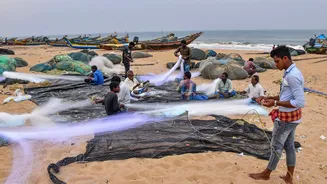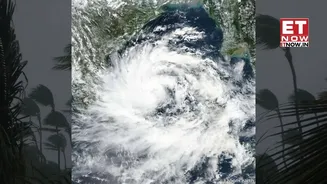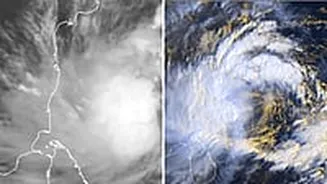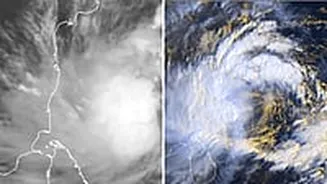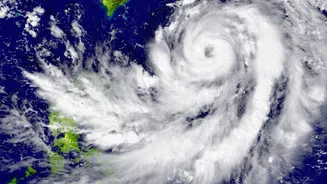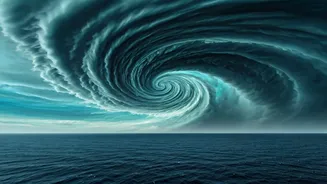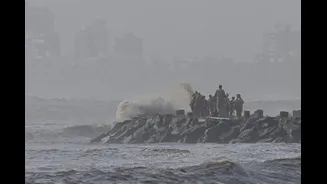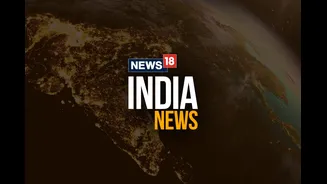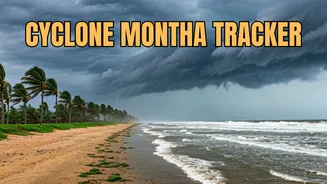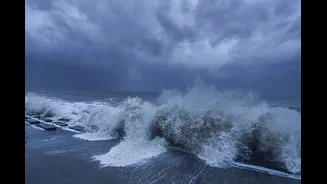The weather system, which is currently over the Bay of Bengal, is set to make landfall on Tuesday in Andhra Pradesh. Authorities have said that evacuation efforts are in full swing, essential supplies are being procured, and disaster teams are being deployed.
As of 1 pm, it was moving at a speed of 18 kilometres and was around 520 kilometres from Chennai and 600 kilometres from Visakhapatnam, according to the Andhra Pradesh State Disaster Management Authority (APSDMA).
But what are tropical storms? How are they named? How deadly is Montha expected to be?
Let’s take a closer look.
What are tropical storms?
They are powerful low-pressure weather systems. They are characterised by strong and violent winds, torrential rainfall, storm waves, and flooding.
They usually form over warm tropical oceans, around 26.5 degrees centigrade, where enough energy – moisture and heat – is present. They have surface wind speeds of around 63 to 118 kilometres per hour. They are classified based on their wind speed, central pressure, and potential danger.
You may well ask if a cyclone is the same thing as a tropical storm.
Not exactly. You see, a cyclone is a general term for a massive air system moving around the centre of a low-pressure area, whereas a tropical storm develops around warm tropical or subtropical ocean waters. When its wind speed exceeds 119 kilometres per hour, the storm is classified as an intense tropical cyclone.
A tropical cyclone is given different names depending on where you live. For example:
- In the United States and the Caribbean, they are known as hurricanes
- In South Asia, they are known as cyclones
- In East Asia, they are called typhoons
- In Australia, they are called willy-willies
According to the US National Oceanic and Atmospheric Administration website, tropical cyclones occur in India when “thunderstorm activity starts building close to the centre of circulation, and the strongest winds and rain are no longer in a band far from the centre”.
How are they named?
They are named by countries on a rotational basis. But how is this done?
Way back in 2000, the World Meteorological Organization (WMO) and the UN Economic and Social Commission for Asia and the Pacific (ESCAP) decided to begin naming cyclones. The group initially comprised Bangladesh, India, the Maldives, Myanmar, Oman, Pakistan, Sri Lanka, and Thailand. However, it later added Iran, Qatar, Saudi Arabia, United Arab Emirates, and Yemen. The WMO and ESCAP jointly finalised the names after every country sent in suggestions.
Each country sends a list of 13 suggestions – bringing the total to 169 names. When a new cyclone forms, a new name is picked from the list after the countries are arranged in alphabetical order.
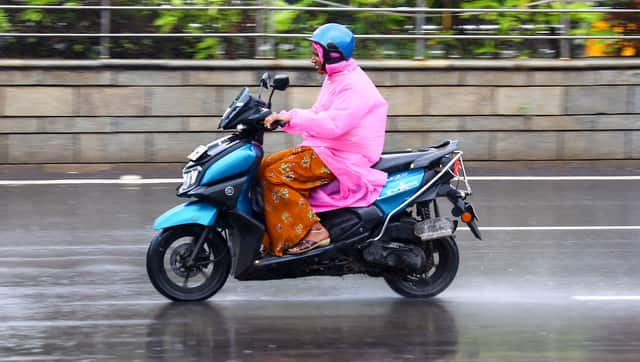
A woman rides a two-wheeler amid rain owing to Cyclone 'Montha', in Chennai on Monday. PTI
The list of names has nothing to do with gender, politics, religion, or culture. The names are used sequentially by column. Once a name is used, it is not reassigned again. The cyclones, which are tracked by satellite, are given names so that they can be easily identified for the public by authorities, allowing awareness about them to be increased.
It was Thailand that contributed the name Montha, which means fragrant flower or beautiful flower. Some of the previous names used were Shakhti (Sri Lanka), Fengal (Saudi Arabia), Dana (Qatar), Asna (Pakistan), and Remal (Oman). The next cyclones will be named Senyar (UAE), Ditwah (Yemen), Arnab (Bangladesh), and Murasu (India). Though it was a trend to assign feminine and masculine names to storms earlier, this is no longer the case.
How deadly is Montha expected to be?
The cyclone will likely intensify further by Tuesday morning.
By the time it crosses Andhra Pradesh’s coast tomorrow night, it will be gusting at winds between 90 and 110 kilometres per hour before it makes landfall near Kakinada on October 28. Kakinada will witness a storm surge raising water levels by 1 to 2 metres. Little wonder then that the IMD has issued red and orange alerts for nearly two dozen districts in Andhra Pradesh.
The state government is taking no chances, having deployed multiple State Disaster Response Force and National Disaster Response Force teams across several districts. People living in low-lying areas and vulnerable locations, including pregnant women and senior citizens, have been evacuated to relief camps out of harm’s way.
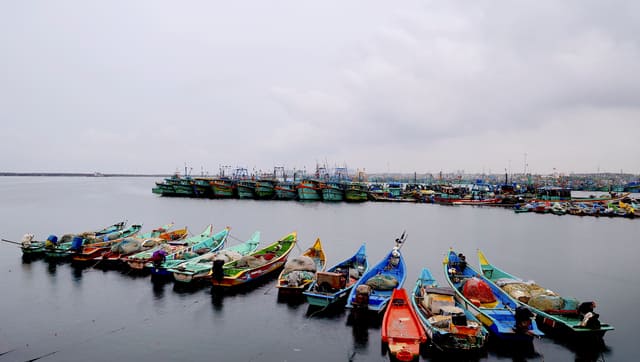
Boats docked at Kasimedu fishing harbour following the heavy rainfall forecast owing to Cyclone 'Montha'. PTI
In Kakinada, which is where the cyclone will make landfall, the government has set up 260 relief centres. Another 140 relief camps have been established in Nellore. These camps have been filled with rations and food. Beaches have been shut, and fishermen warned not to head out into the sea.
“People should stay indoors and stay safe. Don’t be complacent as the weather seems calm,” Andhra Pradesh Chief Minister Chandrababu Naidu announced.
Municipal Administration and Urban Development Minister P Narayana, who is in charge of Kakinada, was quoted as saying by
The IMD, meanwhile, has issued a heavy rain advisory for multiple other states, including Tamil Nadu, Telangana, and the Union Territory of Puducherry over the next few days. Odisha will likely receive heavy rainfall on October 28 and 29, and the districts of Ganjam, Gajapati, Rayagada, Koraput, and Malkangiri have been placed on alert.
West Bengal, Sikkim, Jharkhand, and Bihar will witness light to moderate rainfall, with heavy rainfall at isolated places. South 24 Parganas, Medinipur, and Kolkata in West Bengal will likely see heavy rain.
With inputs from agencies
